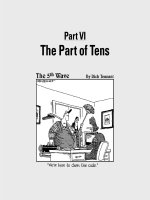The Anatomy of Collaboration Diagrams
Bạn đang xem bản rút gọn của tài liệu. Xem và tải ngay bản đầy đủ của tài liệu tại đây (268.5 KB, 43 trang )
37
OOAD Sử dụng UML - Phân tích Use-Case
Dương Anh Đức 9/2000
37
The Anatomy of Collaboration Diagrams
The Anatomy of Collaboration Diagrams
:Client
:Supplier
Client Object
Link
Supplier Object
1: PerformResponsibility
Message
38
OOAD Sử dụng UML - Phân tích Use-Case
Dương Anh Đức 9/2000
38
Ví duï:
Ví duï:
Collaboration Diagram
Collaboration Diagram
: Student
: RegisterForCoursesForm
: RegistrationController
:
Schedule
: Student
: CourseCatalogSystem
1.2. // display course offerings( )
1.3. // display blank schedule( )
: Course Catalog
1. // create schedule( )
2. // select 4 primary and 2 alternate offerings( )
1.1. // get course offerings( )
2.1. // create schedule with offerings( )
2.1.1. // create with offerings( )
1.1.1. // get course offerings(forSemester)
2.1.2. // add schedule(Schedule)
1.1.1.1. // get course offerings( )
39
OOAD Sử dụng UML - Phân tích Use-Case
Dương Anh Đức 9/2000
39
Ví duï:
Ví duï:
Collaboration Diagram (cont.)
Collaboration Diagram (cont.)
:
CourseOffering
: Student
:
RegistrationController
:
Schedule
: Student
:
PrimaryScheduleOfferingInfob
1.1.2.4. // any conflicts?( )
: RegisterForCoursesForm
1. // submit schedule( )
1.1. // submit schedule( )
1.1.2. // submit( )
1.1.1. // save( )
1.1.2.3. // still open?( )
1.1.2.5. // add student(Schedule)
1.1.2.1. // is selected?( )
1.1.2.6. // mark as enrolled in( )
1.1.2.2. // has pre-requisites(CourseOffering)
40
OOAD Sử dụng UML - Phân tích Use-Case
Dương Anh Đức 9/2000
40
One Interaction Diagram Not Good Enough
One Interaction Diagram Not Good Enough
Basic Flow
Alternate Flow 1 Alternate Flow 2 Alternate Flow 3
AF1
AF2
AF3
Alternate Flow 4 Alternate Flow 5 Alternate Flow n
41
OOAD Sử dụng UML - Phân tích Use-Case
Dương Anh Đức 9/2000
41
Collaboration Diagrams Vs Sequence Diagrams
Collaboration Diagrams Vs Sequence Diagrams
z
Collaboration
Diagrams
–Chỉ ra các mối quan hệ
bổ sung cho các tương
tác
–Trực quan hóa tốt hơn
các mẫu cộng tác
–Trực quan hóa tốt hơn
các hiệu ứng tác động
lên một đối tượng cụ
–Dễ sử dụng hơn trong
các v/đ cần g/q tập thể
z
Sequence Diagrams
–Chỉ ra rõ ràng chuỗi
các thông điệp
–Trực quan hóa tốt hơn
toàn bộ luồng sự kiện
–Tốt hơn cho các đặc tả
real-time và cho các
scenario phức tạp
42
OOAD Sử dụng UML - Phân tích Use-Case
Dương Anh Đức 9/2000
42
Exercise: Use
Exercise: Use
-
-
Case Analysis, Part 1
Case Analysis, Part 1
z
Hãy xây dựng:
– Use-Case Model, đặc biệt là các use-case
flows of events
–Các trừu tượng hóa/class then chốt
(còn tiếp)
43
OOAD Sử dụng UML - Phân tích Use-Case
Dương Anh Đức 9/2000
43
Exercise: Use
Exercise: Use
-
-
Case Analysis, Part 1 (cont.)
Case Analysis, Part 1 (cont.)
z
Hãy xác định các thông tin sau cho mộtuse
case cụ thể:
– Các analysis class, cùng với chúng là:
z
Brief descriptions
z
Stereotypes
z
Responsibilities
– Các collaboration cần thiết để cài đặt use case
(còn tiếp)
44
OOAD Sử dụng UML - Phân tích Use-Case
Dương Anh Đức 9/2000
44
Exercise: Use
Exercise: Use
-
-
Case Analysis, Part 1 (cont.)
Case Analysis, Part 1 (cont.)
z
Với một use case cụ thể, hãy thiết lập:
– Use-case realization interaction diagram cho tối
thiểumột trong các use-case flows of events
45
OOAD Sử dụng UML - Phân tích Use-Case
Dương Anh Đức 9/2000
45
Use
Use
-
-
Case Analysis Steps
Case Analysis Steps
z
Bổ sung các mô tả của Use-Case
z
Đ/v mỗi use-case realization
– Tìm các Class từ Use-Case Behavior
– Phân bổ Use-Case Behavior cho các Class
z
Đ/v mỗi analysis class tìm được
–Mô tả các nhiệm vụ của chúng
– Mô tả các Attribute và Association
– Lượng giá các Analysis Mechanism
z
Hợp nhất các Analysis Class
z
Checkpoints
46
OOAD Sử dụng UML - Phân tích Use-Case
Dương Anh Đức 9/2000
46
Describe Responsibilities
Describe Responsibilities
z
Trách nhiệm (responsibilities) là gì?
z
Làm thế nào để tìm ra chúng?
Interaction Diagram
// PerformResponsibility
:Client :Supplier
Class Diagram
Supplier
// PerformResponsibility
47
OOAD Sử dụng UML - Phân tích Use-Case
Dương Anh Đức 9/2000
47
RegisterForCoursesForm
// submit schedule()
// display course offerings()
// display schedule()
// create schedule()
// select 4 primary and 2 alternate offerings()
// display blank schedule()
<<boundary>>
PrimaryScheduleOfferingInfo
grade
// is enrolled in?()
// mark as enrolled in()
<<entity>>
CourseCatalogSystem
// get course offerings()
<<boundary>>RegistrationController
// get course offerings()
// submit schedule()
// create schedule with offerings()
<<control>>
Student
// add schedule()
// has pre-requisites()
<<entity>>
ScheduleOfferingInfo
status
// mark as selected()
// mark as cancelled()
// is selected?()
<<entity>>
CourseOffering
number : String = "100"
startTime : Time
endTime : Time
days : Enum
// add student()
// still open?()
// save()
<<entity>>
Schedule
// create with offerings()
// submit()
// save()
<<entity>>
Ví duï:
Ví duï:
View of Participating Classes (VOPC) Class
View of Participating Classes (VOPC) Class
Diagram
Diagram
48
OOAD Sử dụng UML - Phân tích Use-Case
Dương Anh Đức 9/2000
48
Maintaining Consistency: What to Look For
Maintaining Consistency: What to Look For
z
In order of criticality
– Redundant responsibilities across classes
– Disjoint responsibilities within classes
– Class with one responsibility
– Class with no responsibilities
– Better distribution of behavior
– Class that interacts with many other classes
49
OOAD Sử dụng UML - Phân tích Use-Case
Dương Anh Đức 9/2000
49
Use
Use
-
-
Case Analysis Steps
Case Analysis Steps
z
Bổ sung các mô tả của Use-Case
z
Đ/v mỗi use-case realization
– Tìm các Class từ Use-Case Behavior
– Phân bổ Use-Case Behavior cho các Class
z
Đ/v mỗi analysis class tìm được
– Mô tả các nhiệm vụ của chúng
–Mô tả các Attribute và Association
– Lượng giá các Analysis Mechanism
z
Hợp nhất các Analysis Class
z
Checkpoints
50
OOAD Sử dụng UML - Phân tích Use-Case
Dương Anh Đức 9/2000
50
Describe Attributes and Associations
Describe Attributes and Associations
z
Định nghĩa các Attribute
z
Thiết lập các mối quan hệ dạng
Aggregation và Association
51
OOAD Sử dụng UML - Phân tích Use-Case
Dương Anh Đức 9/2000
51
Review: What is an Attribute?
Review: What is an Attribute?
ClassName
<<stereotype>>
Attribute : Type = InitValue
Attribute : Type = InitValue
Attribute : Type = InitValue
Trong analysis, không nên
tốn nhiều thời gian cho
việc xác định các attribute
signature
CourseOffering
<<entity>>
number :String=“100”
startTime : Time
endTime: Time
days: enum
attribute
52
OOAD Sử dụng UML - Phân tích Use-Case
Dương Anh Đức 9/2000
52
Finding Attributes
Finding Attributes
z
Các thuộc tính/đặc điểmcủa các class
z
Các thông tin ddc giữ lại bởi các class
z
Các “danh từ” không biến thành class
– Các thông tin mà giá trị của chúng là quan
trọng
– Các thông tin ddc sở hữu bởi 1 object duy nhất
– Các thông tin không có hành vi
53
OOAD Sử dụng UML - Phân tích Use-Case
Dương Anh Đức 9/2000
53
Review: What is an Association?
Review: What is an Association?
z
Mô hình hóa một liên hệ ngữ nghĩagiữa
các thể hiện (instances) của các class
Simple
association
<<entity>>
Student
<<entity>>
Schedule
<<entity>>
CourseOffering
Reflexive
association
is a pre-requisite of
<<entity>>
Course
Association là một quan hệ cấu trúc









